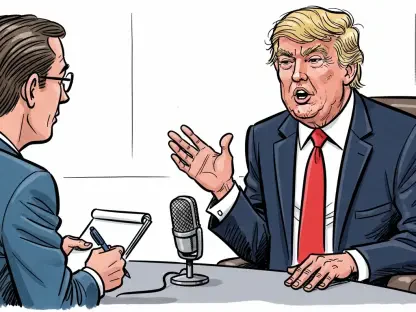Scott Kupor, formerly a prominent figure in venture capital, brings a fresh perspective as the head of the Office of Personnel Management (OPM). With a strategic approach to operational efficiency, Kupor’s leadership stands at a crucial juncture, aiming to institute transformative changes across the agency and the broader governmental landscape. His experience in maximizing efficiency uniquely positions him to tackle the government’s need for enhanced operational practices. The significance of Kupor’s strategy is paramount, as it has the potential to reshape OPM into a pioneering model of efficiency.
Historical Overview of Operational Efficiency at OPM
Since its inception, OPM has faced ongoing challenges with operational efficiency. The agency’s history is marked by periodic attempts at modernization and significant legacy issues that have hindered seamless operations. Notably, during the Trump administration, the Department of Government Efficiency (DOGE) implemented workforce reductions at OPM, a move that led to significant personnel restructuring. As Kupor steps in, understanding the historical context of these changes is crucial in evaluating the potential success of his strategies.
In previous years, OPM’s structure often leaned toward bureaucratic inefficiencies. The sprawling agency, tasked with managing human resources across the federal government, struggled against the weight of entrenched procedural hurdles. Against this backdrop, Kupor’s venture capital acumen provides a beacon of hope for orchestrating a much-needed overhaul in operational methodologies.
Kupor’s Strategic Milestones and Initiatives
Kupor’s tenure at OPM has already been marked by several strategic initiatives aimed at streamlining efficiency. At the forefront of his agenda is addressing the legacy workforce reductions and their impact on essential services. He has identified service gaps due to these staff losses and seeks to recalibrate the workforce to ensure that critical roles are restored where necessary.
Workforce Optimization Efforts
One of Kupor’s significant achievements is his focus on workforce optimization. Part of his strategy involves examining the department’s headcount, which has been drastically reduced, ensuring roles that are vital to OPM’s success are filled. This move involves a careful analysis of which roles need to be reinstated, balancing the need for efficiency with adequate personnel.
Technological Advancements and Innovation
Kupor is also pioneering technological advancements within OPM. He recognizes the vital role of technology, particularly artificial intelligence, in propelling OPM toward greater efficiency. His efforts are directed at recruiting technological expertise to enhance the agency’s capabilities, ensuring that modernization aligns with the agency’s strategic goals.
Fiscal Responsibility Measures
Fiscal responsibility forms a core component of Kupor’s strategy, emphasizing a reduction in the agency’s contractor pool by half. This move is crafted to optimize spending while maintaining essential functions, enhancing the agency’s ability to operate within its budgetary constraints effectively.
Distinguishing OPM’s Strategies from Other Agencies
Kupor’s approach distinctly sets OPM apart from other government agencies. Unlike the overarching mandates often seen at agencies like DOGE, Kupor insists on maintaining OPM’s autonomy. He fosters an environment where collaboration is encouraged, yet insists that decisions are tailored to the agency’s specific needs and aspirations.
While cooperation with other agencies is a consideration, Kupor’s strategies emphasize independence in decision-making processes. This autonomy allows OPM to tailor its initiatives to fit its unique circumstances, a move that could position the agency as a leader in government efficiency.
Current State of OPM’s Operations and Future Directions
Today, OPM is actively pursuing multiple initiatives under Kupor’s guidance, focused on bolstering its operational efficiency. Current endeavors include restoring critical roles, enhancing technological frameworks, and cementing fiscal measures to ensure sustainable operations. With Kupor’s strategic eye, the agency is poised to tackle ongoing challenges while paving the way for future advancements.
Looking ahead, Kupor’s vision is steering OPM toward becoming not only more efficient but also an attractive workplace for talented individuals eager to tackle governmental challenges. The agency is revamping its recruitment strategies to draw in innovative thinkers who are passionate about public service.
Reflection and Broader Impacts
Scott Kupor’s strategy at OPM is already making waves, with potential implications that extend beyond the agency. His leadership is reshaping perceptions of efficiency within government operations and encouraging a culture of innovation and accountability.
Reflection on Kupor’s Leadership
Kupor’s leadership is characterized by a pragmatic approach to challenges, leveraging his experience in venture capital to navigate government complexities. While his strategies show promise, the task of reviving an agency entrenched in traditional practices presents formidable challenges that require adaptive leadership and resilient resolve.
Broader Implications for Government Efficiency
The broader implications of Kupor’s strategies indicate a shift toward a paradigm where government agencies can operate with business-like efficiency. His emphasis on innovation, fiscal responsibility, and autonomy might serve as a blueprint for other agencies, fostering a more dynamic and efficient governmental framework across various sectors.
Conclusion and Call to Action
Scott Kupor’s dynamic approach is transforming OPM, but the journey toward optimal efficiency requires continued effort and innovative thinking. His leadership highlights how strategic foresight, coupled with pragmatic measures, can enhance governmental operations. By focusing on restoring essential roles, modernizing technology, and enforcing fiscal discipline, Kupor is setting OPM on a path to becoming a model of efficiency. Engaging stakeholders and encouraging public interest in these initiatives is crucial as OPM continues its journey toward efficiency and effectiveness in serving the public good.









